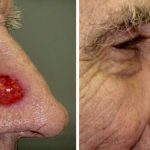History of Radiotherapy in Dermatology
Radiotherapy was born shortly after discovery of radiation by the Marie Curie and Peter Curie in 1889. First report of radiotherapy used for malignancy was published in 1896 in Medical Record by Victor Despeignes who treated a patient with gastric cancer in France. Émil Grubbé, a medical student in Chicago at the time, would later claim to have been the first to treat cancer patients with X-rays in 1896. First successful treatment of malignant skin lesions (rodent ulcer, i.e. basal cell carcinoma, and epithelioma) were reported by Thor Stenbeck and Tage Sjogen of Sweden in 1899. Within a few months, scientific journals were inundated with reports of successful treatment using X-rays for different skin malignancies.
The following 20 years were characterized by exploration of radiation technology with various clinical applications and radiation complications. Between 1922 and 1934, Henri Coutard, working with the Radium Institute in Paris developed the first protracted, fractionated course of radiation for head and neck cancers – the concept we still employ today. In the 1940’s and 50’s the science of radiotherapy continued to be refined with appropriate dosage regimens. Data was continued to be collected and published in the 1960’s proving efficacy and safety of radiotherapy.
A comprehensive survey was performed by the Task Force on Ionizing Radiation of the National Program for Dermatology of the American Academy of Dermatology, which evaluated the usage of ionizing radiation by dermatologists in 1974. A detailed questionnaire was mailed to 4560 dermatologist in US and Canada, with 2444 responses received. At that time, 55.5% of dermatology offices (2305 replies) had superficial x-ray and/or Grenz-ray equipment. 44.3% of dermatologists used superficial x-ray or grenz rays regularly. Clinical instruction during residency training was considered good by 37.4%, adequate by 22.2% and poor by 27.1% of respondents. One-fifth (18.3%) received no practical training.
Something happened in the 1970’s as radiotherapy popularity in dermatology began to rapidly decline. Dr. Z. Charles Fixler from Cincinatti helped me fill in the blanks. He like many dermatologists at the time received training in radiotherapy during his residency in the 1950’s. Upon opening his private practice he purchased a Profex X-ray machine in 1957 and inherited a Universal X-ray machine from another dermatologist, both of which Dr. Fixler is still using. The machines has been regularly maintained and certified by physicists for 56 years and are still going strong. Dr. Fixler also owns a Grenz X-ray machine made by X-Cel, although he has not used it for benign skin conditions for many years. He currently uses his Universal and Profex X-ray machines at 80 kVp energy delivering 600 cGy 2 times per week for 3 weeks for BCCa and 700 cGy 2 times per week for 3 weeks for SCCa. His patients are mostly elderly and travel significant distances making his fractionation regimen practical and appropriate.
In the 1970’s, Dr. Fixler also noted that many dermatologists stopped using radiotherapy. At one point there were up to 30 dermatologists performing radiation therapy in the Cincinnati area. Within a few years, only 3 were left. Today, strong at 87, Dr. Fixler and his associate – his son – are the only dermatologist in the area providing radiotherapy for 100-150 patients per year.
He attributes several possible reasons for the abandonment of radiotherapy by dermatologists. As he put it, “Government scared everybody” with regulations, enforcement, and licensure. Room shielding requirements, physicist equipment calibration, and licensure fees could have been a factor. He also recalled a circulated scare of secondary radiation effects on distant organs such as the thyroid gland. That fear was unwarranted as simple shielding avoided that risk.
Another factor was economic – a reduction in payments for radiotherapy treatments discouraged many dermatologists. Emergence of Mohs surgery at the time cannot be underestimated. Its natural attraction as a hands-on surgical procedure, its increasing reimbursement, and growing acceptance may have been the coup de gras of radiotherapy. In 1967 the American College of Chemosurgery was established, and by the 1970s some dermatology Residency programs had begun offering Mohs surgical training. The rest is history.
Additionally, a significant number of radiation oncologists also use this X-ray technology (while all radiation oncologists use LINAC electron beam therapy). In Europe, the story is substantially different, with widespread use of superficial radiotherapy in many skin cancer centers by dermatologists and radiation oncologists alike.
Despite this, some 30 dermatologists are currently using superficial radiotherapy in the United States primarily for skin cancer
Today in the US, we see a re-emergence of interest in radiotherapy for skin cancers as new equipment has been introduced to the market by companies such as Sensus and Xstrahl (Gulmay). Several academic dermatology departments have acquired these machines and re-introduced radiotherapy to their training programs. Perhaps, radiotherapy for skin cancers works in 40 year cycles. Henri Coutard in 1930’s established the first fractionated regimen for skin cancers. In 1970’s it was abandoned by dermatologists en masse, and in 2010’s it reemerged. Perhaps, by 2050’s we will have cured cancer with targeted genetic therapy making radiotherapy obsolete again.
References:
1. Advances in Radiotherapy and Implications for the Next Century: A Historical Perspective
2. History of Radiation Therapy
3. Goldschmidt H. Ionizing radiation therapy in dermatology. Current use in the United States and Canada. Arch Dermatol 1975; 111(11): 1511-7
4. Phone Interview, Z. Charles Fixler, MD, Cincinnati, OH. Oct

